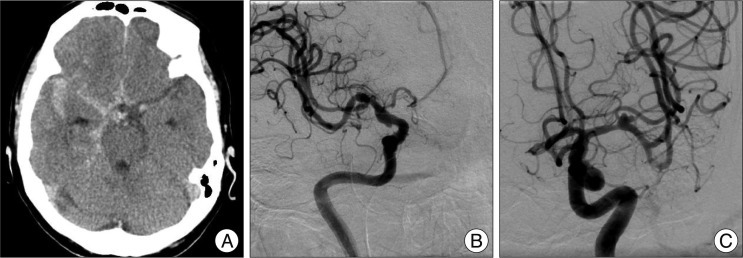J Korean Neurosurg Soc.
2012 May;51(5):296-300. 10.3340/jkns.2012.51.5.296.
Stent-Assisted Coil Trapping in a Manual Internal Carotid Artery Compression Test for the Treatment of a Fusiform Dissecting Aneurysm
- Affiliations
-
- 1Department of Neurosurgery, Gospel Hospital, Kosin University College of Medicine, Busan, Korea. ysparkns@kosinmed.or.kr
- KMID: 2066930
- DOI: http://doi.org/10.3340/jkns.2012.51.5.296
Abstract
- Internal carotid artery (ICA) trapping can be used for the treatment of giant intracranial aneurysms, blood blister-like aneurysms, and fusiform dissecting aneurysms. Fusiform dissecting aneurysms are challenging to treat surgically and endovascularly because of no definite neck and critical perforators. Surgical or endovascular trapping of the ICA with or without an extracranial-intracranial bypass has commonly been used as an effective method to treat these lesions, but balloon test occlusion (BTO) must be performed. Here, we report a case of a ruptured fusiform dissecting aneurysm of the distal ICA, which was successfully treated using an endovascular ICA trapping with a manual ICA compression test instead of BTO.
Figure
Reference
-
1. Abud DG, Spelle L, Piotin M, Mounayer C, Vanzin JR, Moret J. Venous phase timing during balloon test occlusion as a criterion for permanent internal carotid artery sacrifice. AJNR Am J Neuroradiol. 2005; 26:2602–2609. PMID: 16286409.2. Aoki Y, Nemoto M, Yokota K, Kano T, Goto S, Sugo N. Ruptured fusiform aneurysm of the proximal anterior cerebral artery (A1 segment). Neurol Med Chir (Tokyo). 2007; 47:351–355. PMID: 17721050.
Article3. Bernardini GL, Mayer SA, Kossoff SB, Hacein-Bey L, Solomon RA, Pile-Spellman J. Anticoagulation and induced hypertension after endovascular treatment for ruptured intracranial aneurysms. Crit Care Med. 2001; 29:641–644. PMID: 11373436.
Article4. Charbel FT, Gonzales-Portillo G, Hoffman W, Cochran E. Distal internal carotid artery pseudoaneurysms : technique and pitfalls of surgical management : two technical case reports. Neurosurgery. 1999; 45:643–648. discussion 648-649. PMID: 10493387.5. Chung JH, Shin YS, Lim YC, Park M. Ideal internal carotid artery trapping technique without bypass in a patient with insufficient collateral flow. J Korean Neurosurg Soc. 2009; 45:260–263. PMID: 19444357.
Article6. Hetzel A, von Reutern G, Wernz MG, Droste DW, Schumacher M. The carotid compression test for therapeutic occlusion of the internal carotid artery. Comparison of angiography with transcranial Doppler sonography. Cerebrovasc Dis. 2000; 10:194–199. PMID: 10773645.
Article7. Higashida RT, Smith W, Gress D, Urwin R, Dowd CF, Balousek PA, et al. Intravascular stent and endovascular coil placement for a ruptured fusiform aneurysm of the basilar artery. Case report and review of the literature. J Neurosurg. 1997; 87:944–949. PMID: 9384409.
Article8. Islam MS, Manabe H, Hasegawa S, Takemura A, Nagahata M. Successful staged treatment for ruptured blister-like dissecting aneurysm of the intracranial internal carotid artery : acute GDC embolization for the blister-like aneurysm followed by proximal occlusion with extracranial-intracranial bypass in the chronic stage. Minim Invasive Neurosurg. 2004; 47:165–168. PMID: 15343433.
Article9. Lawton MT, Hamilton MG, Morcos JJ, Spetzler RF. Revascularization and aneurysm surgery : current techniques, indications, and outcome. Neurosurgery. 1996; 38:83–92. discussion 92-94. PMID: 8747955.10. Little JR, St Louis P, Weinstein M, Dohn DF. Giant fusiform aneurysm of the cerebral arteries. Stroke. 1981; 12:183–188. PMID: 7233461.
Article11. Mericle RA, Lanzino G, Wakhloo AK, Guterman LR, Hopkins LN. Stenting and secondary coiling of intracranial internal carotid artery aneurysm : technical case report. Neurosurgery. 1998; 43:1229–1234. PMID: 9802870.12. Park JH, Park IS, Han DH, Kim SH, Oh CW, Kim JE, et al. Endovascular treatment of blood blister-like aneurysms of the internal carotid artery. J Neurosurg. 2007; 106:812–819. PMID: 17542524.
Article13. Peterman SB, Taylor A Jr, Hoffman JC Jr. Improved detection of cerebral hypoperfusion with internal carotid balloon test occlusion and 99mTc-HMPAO cerebral perfusion SPECT imaging. AJNR Am J Neuroradiol. 1991; 12:1035–1041. PMID: 1763721.14. Redekop GJ, Woodhurst B. Unusual aneurysms of the distal internal carotid artery. Can J Neurol Sci. 1998; 25:202–208. PMID: 9706721.
Article15. Sakata N, Takebayashi S, Kojima M, Masawa N, Suzuki K, Takatama M, et al. Different roles of arteriosclerosis in the rupture of intracranial dissecting aneurysms. Histopathology. 2001; 38:325–337. PMID: 11318898.
Article
- Full Text Links
- Actions
-
Cited
- CITED
-
- Close
- Share
- Similar articles
-
- Dual Stent-Assisted Coil Embolization for Fusiform Aneurysm Arising From Persistent Trigeminal Artery
- Stent Assisted Coil Embolization of a Dissecting Aneurysm of the Vertebral Artery: A Case Involving a Patient with Hypoplasia of the Contralateral Vertebral Artery
- Serpentine Cavernous Aneurysm Presented with Visual Symptoms Improved by Endovascular Coil Trapping
- Emergent Endovascular Treatment of Ruptured Dissecting Aneurysm of the Intradural Vertebral Artery Using a Self-Expandable Intracranial Stent and a Bioactive Hydrophilic coil
- Subarachnoid Hemorrhage from a Dissecting Aneurysm of the Posterior Cerebral Artery in a Child : Rebleeding after Stent-Assisted Coiling Followed by Stent-Within-Stent Technique




